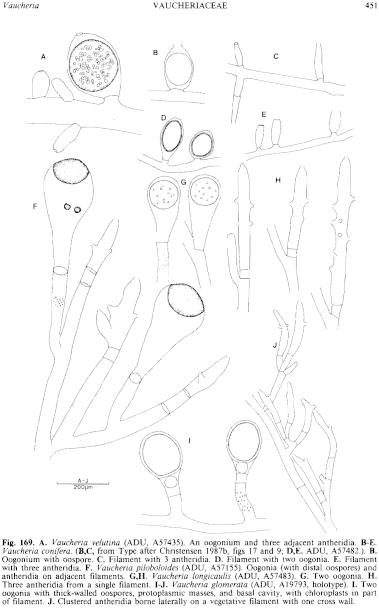|
|
|
|
|
|||||||||||
|
Electronic Flora of South Australia Species Fact Sheet
Phylum Chrysophyta – Class Xanthophyceae – Order Vaucheriales – Family Vaucheriaceae
Thallus medium to dark green, forming dense turfs or tufts with erect filaments, on mud under mangroves or in deeper water. Filaments sparsely branched, 24–45 µm in diameter, with slenderer rhizoids basally; chloroplasts discoid to lanceolate, 1–2 µm across, without (?) pyrenoids.
Reproduction: Sporangia unknown.
Thalli monoecious but with oogonia and antheridia on separate filaments. Oogonia (Fig. 169B,D) sessile on vegetative filaments, more or less erect, ovoid to obovoid, 120–180 µm long and 80–120 µm in diameter, with an apical opening 20–30 µm across, usually with a slightly recurved edge; oospores subspherical to slightly ellipsoid, 90–140 µm long and 90–1 15 AIM in diameter, wall smooth, 3–5 µm thick, with slight to distinct distal and proximal cavities in the oogonium. Antheridia (Fig. 169C,E) usually sessile and erect on vegetative filaments, rarely stalked, cylindrical to slightly ellipsoid or conical, (70–) 80–150 (–180) µm long and (20–) 25–40 µm in diameter, L/D (2–) 2.5–5 (–6) with a large terminal discharge pore.
Type from Garden I., Port Adelaide, S. Aust., under mangroves (Christensen, 8.ix.1981; holotype in ADU, isotype in C).
Distribution: Known from the type locality; 9 km NNE of Port Pirie, S. Aust., in Avicennia woodland (Christensen, 9.ix.1981); and Grange, S. Aust., 20 m deep on tyre reef (Reimers, 24.iv.1987; ADU, A57482).
Taxonomic notes: V. conifera differs from V. velutina in having oogonia and antheridia on separate filaments and the antheridia are longer, with a greater L/D ratio.
The collection (Fig. 169D,E) from an artificial tyre reef, 20 m deep, has somewhat less elongate antheridia than in the type, which came from an intertidal situation, but they are borne on separate filaments as in the type, in contrast to V. velutina. Further study of variation in length and proportions of antheridia is clearly needed.
References:
CHRISTENSEN, T. (1987b). Some collections of Vaucheria (Tribophyceae) from southeastern Australia. Aust. J. Bot. (in press).
The Marine Benthic Flora of Southern Australia Part II complete list of references.
Publication:
Womersley, H.B.S. (14 December, 1987)
The Marine Benthic Flora of Southern Australia
Part II
©Board of the Botanic Gardens and State Herbarium, Government of South Australia
Illustration in Womersley Part II, 1997: FIG. 169 B–E.

Figure 169 enlarge
Fig. 169. A. Vaucheria velutina (ADU, A57435). An oogonium and three adjacent antheridia. B–E. Vaucheria conifera. (B,C,from Type after Christensen 1987b, figs 17 and 9; D,E. ADU, A57482.). B. Oogonium with oospore. C. Filament with 3 antheridia. D. Filament with two oogonia. E. Filament with three antheridia. F. Vaucheria piloboloides (ADU, A57155). Oogonia (with distal oospores) and antheridia on adjacent filaments. G,H. Vaucheria longicaulis (ADU, A57483). G. Two oogonia. H. Three antheridia from a single filament. I–J. Vaucheria glomerata (ADU, A19793, holotype). I. Two oogonia with thick-walled oospores, protoplasmic masses, and basal cavity, with chloroplasts in part of filament. J. Clustered antheridia borne laterally on a vegetative filament with one cross wall.

|
Email Contact: State Herbarium of South Australia |

|